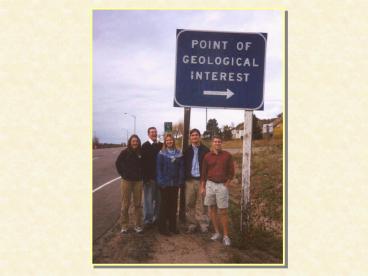White Sands Nat - PowerPoint PPT Presentation
1 / 22
Title:
White Sands Nat
Description:
Form when particles drop from a moving current, such as a flowing river or wind. ... Red = Oxidizing environment. Terrestrial settings. Green = Reducing environment ... – PowerPoint PPT presentation
Number of Views:39
Avg rating:3.0/5.0
Title: White Sands Nat
1
(No Transcript)
2
White Sands Natl Monument, NM Molly Rogers
3
Dolomite Mountains Lea Korsmeyer
4
SEDIMENTARY STRUCTURES
CROSS-BEDDING
Consists of sedimentary layers deposited at an
angle to the underlying set of beds.
Navajo Sandstone Utah
Coconino Sandstone Arizona
5
SEDIMENTARY STRUCTURES
CROSS-BEDDING
Form when particles drop from a moving current,
such as a flowing river or wind. Cross beds
always slope towards the down-current direction.
Consequently, they can be used to indicate
direction of flow.
6
SEDIMENTARY STRUCTURES
CROSS-BEDDING
7
SURFACE SEDIMENTARY STRUCTURES
Surface layers of sedimentary rocks also have
structures.
RIPPLE MARKS
Shallow, curving ridges produced by currents
8
SURFACE SEDIMENTARY STRUCTURES
RIPPLE MARKS
9
SURFACE SEDIMENTARY STRUCTURES
MUD CRACKS
Polygonal cracks that form as mud is exposed to
air and then dries out. Occurs when lakes dry up
or evaporate.
10
LITHIFICATION
When sediments are buried they retain heat. Some
heat comes from buried radioactive grains. Some
heat conducted from Earths interior. Sediments
are also compressed by overlying
sediments. Sediments are invaded by groundwater
carrying ions. Heat, pressure and ions alter the
physical and chemical nature of the sediments by
a processes collectively known as DIAGENESIS.
11
LITHIFICATION
DIAGENESIS can lead to LITHIFICATION. LITHIFICATI
ON is the conversion of loose sediments to solid
sedimentary rocks. Usually occurs in the upper
few kilometers of crust. Temperatures are lt200?C
and at low pressure. Sediments are COMPACTED and
often CEMENTED.
12
LITHIFICATION
COMPACTION - the process by which
pressure reduces the volume of sediment during
diagenesis. Overlying sediment squeezes air and
water out of sediments forcing grains closer
together. Clays have weak attractive forces
which causes grains to adhere and become
SEDIMENTARY ROCK.
13
LITHIFICATION
CEMENTATION takes place as water
circulates between grains and compounds
originally dissolved during chemical weathering
are precipitated and bind sediments
together. Types of cement Calcium carbonate
(CaCO3) Silica (SiO2) Iron oxides (Fe2O3,
FeOOH) Iron sulfide (FeS2) Iron carbonate
(FeCO3) Organic fragments are also compacted and
cemented.
14
LITHIFICATION
Increased heat and pressure can also
cause RECRYSTALLIZATION. Recrystallization is
the development of stable minerals from unstable
varieties. Many marine organisms secrete
aragonite in skeletons. Aragonite recrystallizes
to calcite upon the death of the organism that
produced it. This explains why there is no
aragonite in ancient carbonate rocks.
15
CLASSIFICATION OF SEDIMENTARY ROCKS
Grain-size forms the basis of clastic sedimentary
rock classification.
Sediment Size (mm)
Particle Name
Rock Name
gt256
Boulder
64-256
Cobble
Conglomerate Breccia
Gravel
4-64
Pebble
Granule
2-4
0.063-2
Sand
Sandstone
0.004-0.063
Silt
Siltstone
Mudstone
Mud
lt0.004
Clay
Shale
16
CLASSIFICATION OF SEDIMENTARY ROCKS
CONGLOMERATES AND BRECCIAS
Both have particles sizes gt 2mm. Conglomerates
have rounded grains. Indicates greater
weathering and erosion. Breccias have angular
grains. Indicates less weathering and erosion.
17
CLASSIFICATION OF SEDIMENTARY ROCKS
SANDSTONES
Clastic sedimentary rocks with a grain-size
between 0.063 (1/16) and 2 mm. Represent 25 of
all sedimentary rocks. Are usually cemented by
carbonate (calcite) or silica. gt90 quartz
grains quartz sandstone well sorted and
rounded grains gt25 feldspar arkose poorly
sorted and angular grains gt33 1/3 silt, clay and
rock fragments greywacke poorly sorted and
angular grains
18
CLASSIFICATION OF SEDIMENTARY ROCKS
SANDSTONES
19
CLASSIFICATION OF SEDIMENTARY ROCKS
SANDSTONES
Sandstones are useful as building
stones contain oil, gas and groundwater due
to high porosity and permeability
20
CLASSIFICATION OF SEDIMENTARY ROCKS
MUDSTONES
Grain-size is small, lt 0.063 (1/16) mm. Mudstones
with particles lt0.004 mm in diameter constitute
gt50 of all clastic sedimentary rocks. Usually
extremely fine-grained. Settle out in very quiet
waters. Lakes, lagoons, floodplains and ocean
floors. Generally composed of micas and clay
minerals. These can be oriented parallel to each
other.
21
CLASSIFICATION OF SEDIMENTARY ROCKS
MUDSTONES
Parallel alignment of micas and clays is
termed FISSILITY. SHALE FISSILE mudstone.
22
CLASSIFICATION OF SEDIMENTARY ROCKS
MUDSTONES
Color in MUDSTONES is variable. Color usually
depends on depositional environment. Black
High organic content Low oxygen
content Red Oxidizing environment
Terrestrial settings Green Reducing
environment Marine settings with low O2































